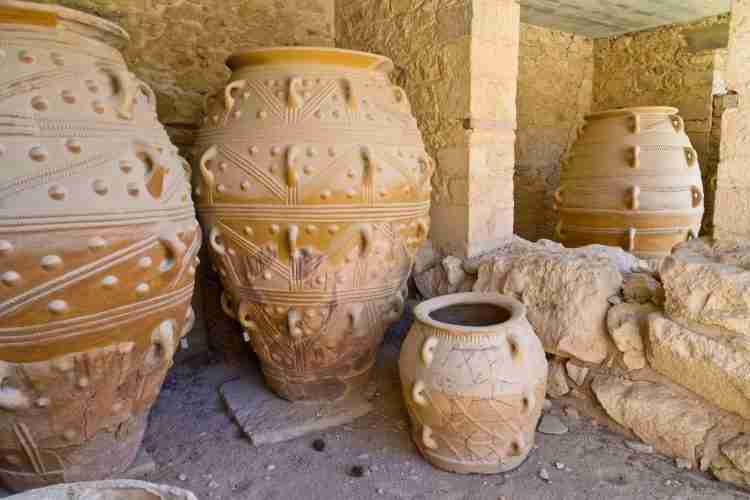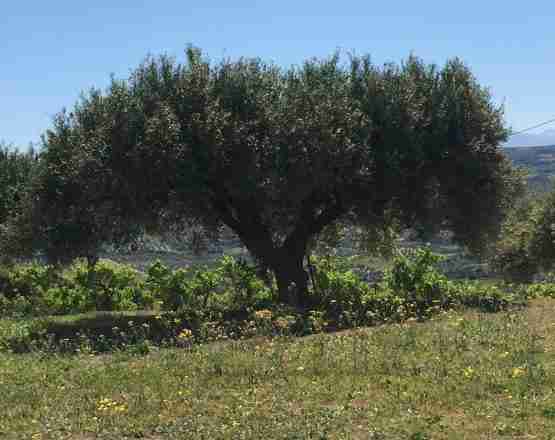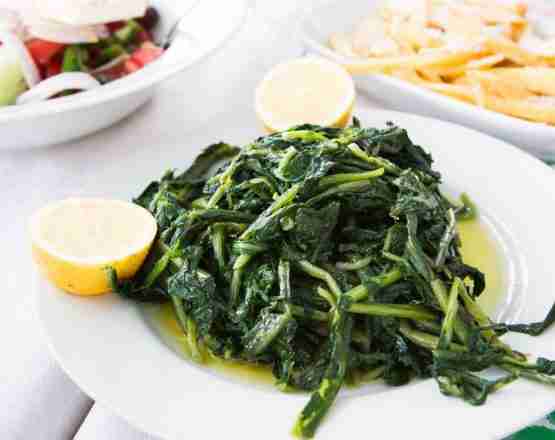MINOAN DIET

The diet of the Bronze Age people of Crete as one has the opportunity to see is surprisingly interesting and modern.
In some aspects even more exotic than the what we today in Crete understand to be the traditional Cretan Mediterranean cuisine.
Based on the finds of the excavations and analysis of the fragmants of pottery animal bones, sea shells we realise that the Minoans Mycenaeans consumed in their every day diet mainly pulses, cereals olives, fruit, vegetables some animal protein and even less sea food.
This diet obviusly is a healthy diet for the heart and beneficial all round once one adds the benefits of olive oil to the above nutrition habit.
In the late 20 century the technology needed physics and chemistry was at a level for scientists to be able to apply modern technology in order to unlock and extract from the evidence left behind by the Minoans to understand more about their diet and trace the link of eating habits of the people of this island from Bronze Age until today.
Zoo archeology \Animal archeology also helped in this understanding as the bones and fragments of animal remains could be examined.
Archeobotany an other new science has provided us with all the valuable information of Aegean andMinoan agriculture.
Of corse radiocarbon dating provided us with the information concerning cereal wine and olive cultivation of Crete.
Crete a large mountainous island that developed an agricultural and maritime economy and structure.
Very probably overseeing if not dominating some times the smaller islands of the cyclades.
The earliest evidence so far of fishing in Greece is in Epirus (Bailey 1992)found in a cave Klithi dated between 15000 and. 10000.BC
Frahthi the Cave in mainland Greece has given us evidence of hunter gatherers and evidence of the animals and fish they hunted.
But by 6500 the farming settlements in Crete are emerging .
Knossos is one of the oldest settlements of Crete and situated beside river 5 kilometres from the sea up on a hill with plenty of grazing areas around it.
The choice of this hill area to reside displays careful thought and good understanding and awareness of agriculture.
From this period from the lowest stratum of Knossos evidence of cattle, pigs, emmer, wheat and barley.
Where these all these native to Crete?
How did they arrive ?
from witch route?
As cultivation in later time became more systematic as the technology of the people evolved small farms with rotating crops of pulses and cereals something still done in rural areas of Crete.
Sheep, goats, cattle ,pigs and horses where kept for meat.
Manure, skins, bones horns for tools and even rituals.
Like in most cultures killing an animal is a either a sacrifice or consumed during special occasions only.
In the late Neolithic period wild ibex of Crete, rabbit, hare, donkey and red deer are domesticated.
With the use of metals and plough better understanding and use of animals for transport enabled the introduction of orchard crops the vine ,nuts, fruits and olive.
As settlements grew as food became more plentiful we enter the Bronze Age of Crete.
The overseeing of parts of Crete and its agricultural resources lead to the establishments known to us today as palaces.
These sites Knossos,Phaistos, Mali, Zakros centres of powerful economical and political manifestations.
Mediterranean diet
The term Mediterranean diet is attributed to Ancel Keyes American Physiologist who tried to establish how eating habits and diet of. The Mediterranean was high in cereal content levels, olive oil and fish that also was related to the absence of cardiovascular disease.
In 1951 Keys studied 7 countries the serum lipid levels of men in rural areas.
Finland,Yugoslavia, Greece, Holland USA and Japan.
From the analysis of Keyes it was noticed that there were notably lower blood serum cholesterol in countries such as Greece .
We must also understand that the Mediterranean diet and its people vary.
The people of the Mediterranean eat less meat fats sugar eggs even than the most Americans, but the Greeks use much more olive oil oil than the Turks or the Italians and the cretans use more olive oil than the main land Greeks.
So the Mediterranean diet has certain characteristics
Low in animal fats.
Rich is vegetables and beens leguminous
Low in animal protein
High in complex carbohydrates
The Greeks have a high level of olive oil approx 60 grams a day.
The vegetable fats consumed by the Cretans is 30 per sent higher than the average American and the saturated fat animal consumption fats 52 present lower.
WHY THE OLIVE OIL
Used for cooking, heating, cosmetics, oils, light, rituals, fresh with vegetables, polishing.
Used as a base for painting colouring, bathing, lubricant.
A very important also trading matereal.
The olive trees today are probably offsprings of the wild olive Olea Chrysophylla , Olea Oleaster, or Olea Europea
In Greece today the wild olive Olea Oleaster is still found as it was more than 4000 years ago.
We see so many paintings of this tree and also decorating their pottery never mind the numerous myths connected with this shallow routed strong enduring tree!
And of corse you realise the Minoans like the Cretans today enjoyed cold pressed olive oil.
This is the Virgin Olive oil.
The olive oil takes 3 months to ripen.
An olive is 50 %water 30% solids and 20% oil.
Because of its high moisture content the fruit has to be processed at once after harvest.
This way avoiding damage due to enzymes.
Olive oil is a mixture of triglycerides monounsaturated fatty acids.Olive oil contains other fatty acids as well.
But olive oil also has sterols, pigments waxes and alcohols all these have therapeutic value as well antioxidants.
The olive oil produced in Bronze Age Crete was as good as the best virgin olive oil today produced on the island.
Here we can appreciate the papyrus of Ancient Egypt concerning the Keftiu and the oil.
Till this day Egypt is behind in the olive oil production.
Homer described olive oil as the green Gold.
From the excavations we see that the Bronze Age Cretans kept their sheep mainly for wool not meat.
Female and male equal in numbers older than 6 or 7 years old, many spindles were found at sites and in many cases such as western Crete we see that the sheep consumed sometimes had been disfigured (Vlazaki.Tzedaki)
As if these animals should be consumed and not let to breed.
Olive oil was the main base of fat in their diet.
The Cereals of Crete
Emmer Wheat being the main cereal crop ,
Single grained einkorn
Hulled barley
Broom corn millet
Oats
Peas,
Lentils,
Vetch acorns.
Rye
Truticum Diococcum. Emmer Wheat
In Linear B tablets we read except from barley reference to figs, flour, wine, oil, honey something still enjoyed in Crete.
FISH
We find series of hooks sea shells drawings of marine life on walls and pottery.
After all Crete is an island and the aegean and mediterranean had until recently so many fish!
We have extensive reference to fish and oysters by Homer in the Iliad and the Odyssey concerning the consumption of fish.
Odyssey xxii 383
But he found all the sort of them fallen in their blood in the dust, like fishes that the
fishermen have drawn forth in the meshes of the net into a hollow of the beach
from out the grey sea, and all the fish, some longing for the salt waves,
Are heaped up on the sand, and the sun shines forth and takes their life away;
So now the wooers lay heaped upon each other.
Today nets fitted with floats on the top and weights at the bottom exactly as they were thousands of years ago.
◦ Tuna,red mullet, anchovy ,sea bream, sardines bonito, swordfish and albacore
Sharks not only for meat but also shark skin for sanding down wood and polishing
As mentioned by Aristotle Palaikastro in eastern Crete has given us plenty samples concerning the fish consumption.
Gournia have given us a number of fishing hooks
Very possibly the Minoans used woven close mesh nets as well.
The Cephalopods
To us it might be a recent notion how good fish is for us but the people of the Aegean enjoyed fish and cephalopods extremely as much ass they could.
Squid and octopus are included in the fatty acid analysis both represented in the Bronze Age !
(Spices herbs from linear tablets
Coriander -Ko-ri-ja-do-no
And Ko-ri-ja-da-na.
19.liters approx per person mentioned in Mycenae
Even larger amounts in Knossos
Cumin
Ku-mi-no.
Possibly a Semitic word
Maratho Dill in Greek today
Ma-ra-tu-wo
Marathon today in main land Greece got its name from this plant.
Sesami
Sa-sa-ma
An other semitic word
Sesami used today in Greek cooking and for making Halvas a sweet.
Celery
Se-ri-no
Mint
Mi-ta
cardamon
Ka-da-mi-ja
GINGER
KO-NO-APO-TE-RA
Caper
Ku-pa-ro
Finikion
Po-ni-ki-jo
Phienicia
The area?
The people with this?
The fruit date?
The Cretans still over Christmas serve a sweet with this name that was introduced by the greeks of Asia Minor cinamon with honey and cheese!
(Minoan Recipie Zakros)
From Zakros we find evidence of lamb cooked with figs!
(Medicinal Recipe of Keftiu in Egypt)
A recipe in Egypt describing a cure of the Keftiu for constipation
Conclusion
At the height the Minoans as a trading and Naval power in the Mediterranean 17 and 16 century BC they seem to have great influence over the photo Greek speakers from main land Greece their writing adapted to the new speech Linear B .
We see depictions of them in wall paintings other local other foreign .
We see representations of the young slender well proportioned and handsome lively looking people.
The men well shaped and very athletic long thick hair, often active and dressed in a manner emphasising their well built and trained body.
Women well set and well built also with long lovely thick hair and a bodice to emphasise their curves.



